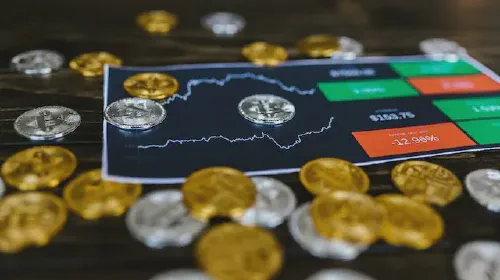The Risks of Staking Crypto
Salomon Kisters
May 12, 2023This post may contain affiliate links. If you use these links to buy something we may earn a commission. Thanks!
Staking is a lucrative option for people who invest in cryptocurrencies and want to profit from their crypto holdings. Compared to mining, it is simpler and requires less time and effort. However, investing in cryptocurrencies can be risky, and staking is no exception. The perils associated with staking are somewhat similar to the general risks of investing in any digital asset.
It is, therefore, important to understand the potential risks that come with staking so that you can make more informed decisions regarding any of your investments in the crypto market. This article will provide you with a comprehensive understanding of the biggest risks of staking and how to avoid them.
It is important not to overlook any details when considering staking as an investment option. By familiarizing yourself with the various risks associated with crypto staking, you can make sure your investments are protected and that you are able to make the most of this exciting opportunity.
What is Crypto Staking?
Crypto staking has become an increasingly popular way to earn money in the digital market. The process involves committing a specific amount of cryptocurrency to support the operations of its blockchain network for a set period of time. By doing so, those who stake their tokens can earn rewards for their contribution.
As we know, decentralization is the backbone of the crypto ecosystem, and staking plays a significant role in maintaining it. It involves holding and locking up a certain amount of cryptocurrency to help secure the network and validate transactions on the blockchain. This process incentivizes participants to act in the best interests of the network, ensuring its reliability, sustainability, and seamless functionality.
By participating in staking, you contribute to the decentralization of the network, making it more resilient to attacks or third-party interference. Thus, staking represents an essential component of the larger crypto ecosystem that helps keep it autonomous and secure.
If we take legacy financial institutions as an example here, we can see that traditional players like banks offer their customers the option of depositing funds into a “high-yield” savings account, where they use these funds from depositors to lend to other customers.
This traditional approach has been around for decades, but with the rise of digital banking, customers are now turning to innovative alternatives that offer even higher returns on their deposits and allow them greater control over their own money.
Staking on the blockchain works similarly to legacy financial institutions in an analogous way. By agreeing to lock up assets, you contribute to the functioning of the blockchain and receive rewards for your contribution. These rewards are calculated in percentage yields that often surpass the interest rates offered by banks.
The Risks of Staking Crypto
Generally speaking, higher rewards often come with higher risks, so simply choosing a crypto token to stake based on the annualized percentage yield (APY) might not be the best approach. It’s essential to consider the common factors that increase the risks involved in staking. Some of these risks are discussed at length next.
Crypto Market Risk
As with any investment, market risk is the most obvious risk involved in staking cryptocurrency. All markets are volatile, and individual assets and securities are even more so. The same applies to crypto assets, as their prices are highly unpredictable and can fluctuate wildly within a short period. It’s important to remember that the value of cryptocurrencies is largely determined by investor sentiment, and as such, they can change quickly based on their perception of the market.
The crypto market, therefore, is a highly volatile space with little or no regulatory regime overseeing trading and staking. Anything that affects the fate of digital assets is likely to cause a disturbance in the market. A prime example of such an occurrence is the recent bear run following the Russian Central Bank’s proposed ban on cryptocurrency in January 2022.
Additionally, the Federal Reserve’s hawkish stance and decision to hike interest rates by March also contributed to the bear run. The market, hence, experienced a temporary reversal in the wider acceptance of digital tokens in the financial sector.
As the upward trend in cryptocurrency ended, investors who were staking their tokens faced a challenging situation. Despite the possibility of earning a higher APY, the market risk became a significant factor that could not be ignored.
With the value of tokens dropping by half throughout the year, investors had to carefully consider which asset they would stake. So it’s essential to monitor the market trends and new developments in the crypto space and stay informed to minimize losses and maximize gains.
Liquidity Risk
Liquidity is a critical factor that cannot be overlooked when it comes to crypto staking. The lack of liquidity can pose a significant threat to an investor’s ability to sell their accumulated assets or convert their staking rewards into more popular assets like Bitcoin or stablecoins. To mitigate liquidity risk, it is essential to stake with tokens that have high liquidity and are listed on reputable exchanges.
By doing so, investors can ensure that they have access to the deep liquidity they need to manage their investments effectively.
Lockup Periods
Some stablecoins come with locked periods, which means that staking these assets can result in them being inaccessible during this period. This is a common feature of some well-known crypto tokens, such as Tron and Cosmos. While it may seem like an inconvenience to investors, locked periods are designed to increase stability and prevent market manipulation.
One way to reduce the risk of lockup is to stake assets without a lockup period. This can be an effective method to minimize the impact of a downward trend in token prices. If your token is facing significant price declines, you may not be able to withdraw your funds to prevent further losses.
However, by staking without a lockup period, you can continue to earn interest at the initially agreed rate and ensure that the dip in token price doesn’t have a significant impact on your overall returns.
Network Operation Risk
In addition to market and liquidity risks, there are certain challenges associated with the day-to-day functioning of a blockchain network. One of these risks is the occurrence of validator node errors. In a Proof-of-Stake network, the validator node plays a crucial role in validating transactions and adding new blocks to the blockchain. It is also responsible for maintaining the integrity of the network and ensuring that all transactions are legitimate.
Interestingly, some crypto networks allow individual users to set up their own validator nodes with only a small amount of tokens and minimal effort. This provides an opportunity for users to earn rewards by actively participating in the network.
Keep in mind, in case your computer malfunctions or encounters an error while staking, you may face penalties that can diminish or reduce your overall rewards. Additionally, if your validator node fails to operate properly, the likelihood of it being selected for transaction processing can be curtailed by the blockchain network.
To avoid this risk, you can assign your crypto tokens to a validator pool, where a group of investors combine their tokens and designate a computer to do all the work, also known as a “staking pool”. The validator in a staking pool, in turn, receives a portion of the reward to compensate for their time and effort. Although this fee varies depending on the cryptocurrency you stake, it is important to avoid reducing your annualized yield from staking.
How Safe is Staking Crypto?
When it comes to understanding how safe crypto staking really is, there are no simple or straightforward answers. Many risks and factors must be taken into account before you can participate in staking or earn rewards from the activity. On one hand, investing in cryptocurrency can be a potential way to diversify your investments and earnings.
On the other hand, staking crypto comes with risks if the system doesn’t work as expected. It is, therefore, advised that you conduct your research properly, stake with only reputable crypto assets, and take into account the overall security of the blockchain where you are investing your cryptocurrency, especially in the case of DPoS.
Moreover, you must also verify the validator before delegating your stake. If you keep your digital currency on a centralized exchange like Binance, there is a possibility that the security of the exchange may be compromised, resulting in the loss of your funds. To minimize this risk, we recommend that you store your cryptocurrency in a “cold” wallet like Ledger or Trezor rather than on the exchange itself.
Overall, staking crypto can be a great way to earn a side income if you take the necessary precautions to minimize the various risks involved. Choosing reputable validators and blockchains is crucial to ensure the security of your assets. With proper risk management strategies and due diligence, staking crypto can be a safe and convenient way to participate in the growing world of decentralized finance.
Final thoughts
With staking, you can put your money to work and earn a somewhat steady income without having to sell your digital assets. Although there are some risks involved in staking your cryptocurrency, staking itself remains a relatively safe and effective way to earn passive income. However, by diversifying your investment and only staking money that you can afford to lose, you can manage the risks while enjoying great returns on your investments.
If you’re looking for alternatives to holding crypto, staking could be a smart move for you. It remains one of the most popular ways to lend out your deposits and earn interest on your stash of crypto even in the most challenging of market conditions.
Stay informed with the latest insights in Crypto, Blockchain, and Cyber-Security! Subscribe to our newsletter now to receive exclusive updates, expert analyses, and current developments directly to your inbox. Don't miss the opportunity to expand your knowledge and stay up-to-date.
Love what you're reading? Subscribe for top stories in Crypto, Blockchain, and Cyber-Security. Stay informed with exclusive updates.
Please note that the Content may have been generated with the Help of AI. The editorial content of OriginStamp AG does not constitute a recommendation for investment or purchase advice. In principle, an investment can also lead to a total loss. Therefore, please seek advice before making an investment decision.

Top 5 Best Places to Stake Ethereum (ETH) - Earn Rewards by Staking ETH
Discover the top 5 best places to stake your Ethereum (ETH) and earn rewards by staking ETH. Learn how to stake ETH on Binance, Coinbase, Kraken, Rocket Pool, and Lido.

Top 4 Best Places to Stake Polygon MATIC - Earn Rewards and Grow Your Holdings
Discover the top 4 best places to stake Polygon MATIC to earn rewards and grow your holdings. Evaluate the benefits and drawbacks of each option to maximize your returns.

Proof-of-Stake: Advantages and Efficiency in Blockchain Consensus
Proof-of-Stake offers cost efficiency, scalability, security, adaptability, decentralization, energy efficiency, boosted security, and faster transaction speeds compared to Proof-of-Work in blockchain consensus.
Protect your documents
Your gateway to unforgeable data. Imprint the authenticity of your information with our blockchain timestamp